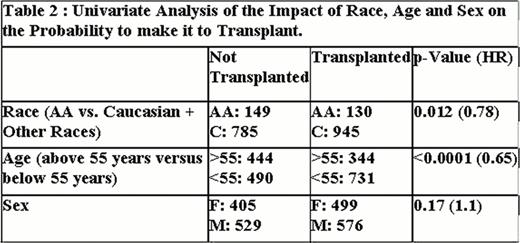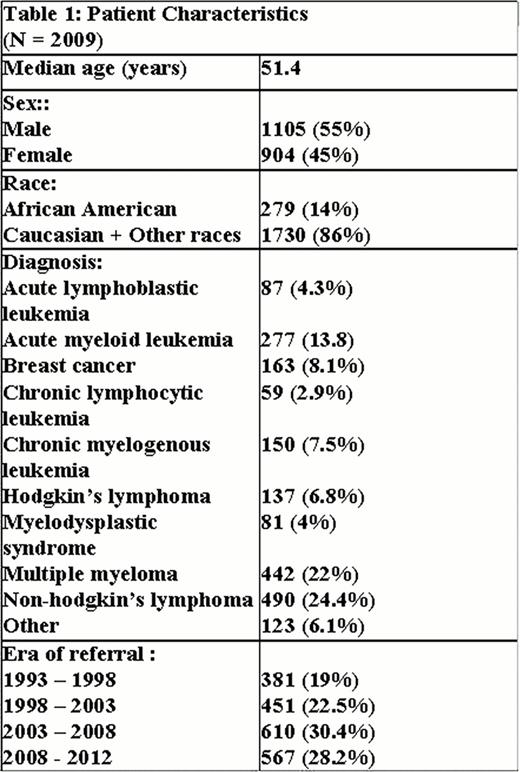Abstract
Abstract 4266
Hematopoietic cell transplantation (HCT) is considered standard of care in patients with numerous types of hematological malignancies. A limited number of large, database derived, retrospective studies have observed the existence of racial disparities between Caucasian and African American patients who are candidates for a transplant for multiple myeloma and other hematological malignancies. We have recently demonstrated that there was no such disparity once a patient with a diagnosis of myeloma was referred to our transplant center. We expanded this analysis to include all patients referred for a transplant with a diagnosis of a hematological malignancy.
We utilized the existing data in our federally-mandated quality management database to retrospectively analyze the potential associations between race and the following parameters: Age, sex, cancer subtype, stage, best response prior to transplant, best response following transplant, treatment related mortality, overall survival, median interval between date of diagnosis and date of referral, median interval between date of initial visit and date of transplant, probability of actually receiving a transplant following formal evaluation by a transplant physician by race, type of transplant recommended and reasons for not receiving a transplant. We reviewed patients referred to consider a transplant within the time period of July 1st 1993 to December 31st2011.
Total number of patients evaluated was 2009. The pertinent patient characteristics are described in Table 1 for this heterogeneous group of patients. Table 2 describes the univariate analysis of the impact of age, race and sex on obtaining a transplant. Both race and age were statistically significant variables for the probability of making it to transplant. The Kaplan-Meier curve for the probability of undergoing a transplant as per race is shown in Figure 1 and is statistically significant with a p-value of 0.0088. We also determined that patient diagnosis is significant in influencing the probability of making it to transplant, p-value of 0.0001. The era of when a patient was referred for transplant (from July/1993 to June/1998 versus July/1998 to December/2011) was also a significant factor for the probability of receiving a transplant, p-value of 0.0001.
We have demonstrated that race, age, disease type and era of patient referral were significant factors in patients receiving a transplant at our institution. Further study is needed to identify the reasons for these barriers in obtaining a transplant.
Univariate Analysis of the Impact of Race, Age and Sex on the Probablity to make it to Transplant.

Kaplan-Meir Curve for the association of race and probability to transplant
Kaplan-Meir Curve for the association of race and probability to transplant
No relevant conflicts of interest to declare.
References
Author notes
Asterisk with author names denotes non-ASH members.



This feature is available to Subscribers Only
Sign In or Create an Account Close Modal